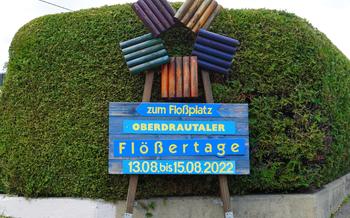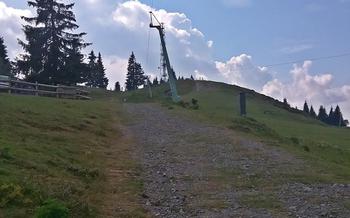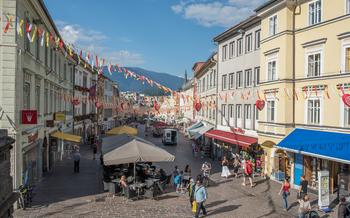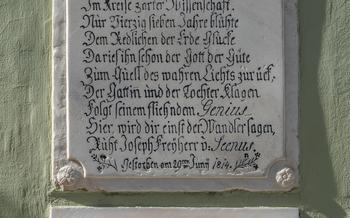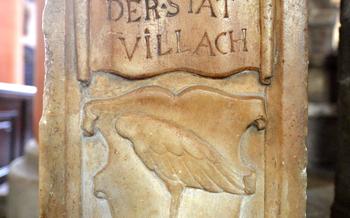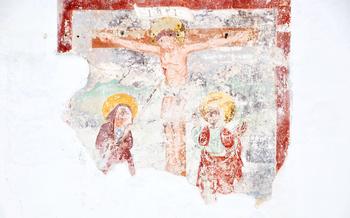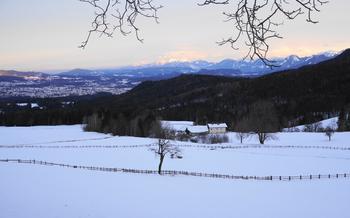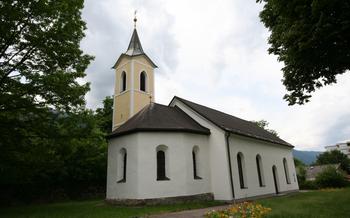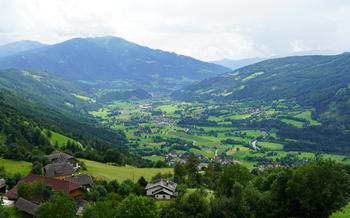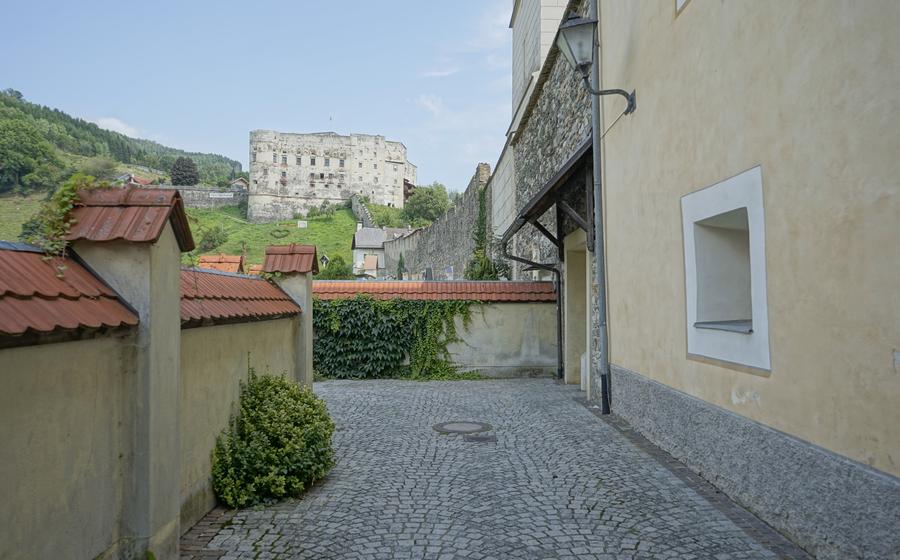
Villach Old Town
- Villach Hauptplatz
- Villach Parish Church
- Villach Clock Tower: A Timeless Landmark
- Villach City Museum
- Villach Drau River Promenade
- Villach Farmers' Market
- Napoleon Bridge:
- Gmünd Cathedral
- Gmünd Town Hall
- Gmünd Museum:
- Gmünd Old City Walls
- Gmünd Minorite Monastery
- Gmünd Outdoor Activities
- Insider Tip
Villach Hauptplatz
Villach Hauptplatz is the heart of the city, a vibrant square lined with historical buildings, charming cafes, and boutiques. The square's centerpiece is the Dreifaltigkeitssäule, a 17th-century plague column adorned with intricate sculptures. Take a seat at one of the outdoor cafes and soak in the lively atmosphere as you people-watch and enjoy a refreshing drink.
Don't miss:
- Villacher Rathaus: A stunning Renaissance town hall that dominates the square.
- Villacher Stadtbrunnen: A 16th-century fountain featuring a bronze statue of Hercules.
- Villacher Sparkasse: A beautiful Art Nouveau building that houses a bank.
Villach Parish Church
The Villach Parish Church, also known as the Church of St. James, is a stunning example of Gothic architecture in the heart of Villach. Its tall steeple dominates the skyline, and its intricate interior is a testament to the skill and artistry of its builders.
The church was first mentioned in records dating back to 1240, but it is believed to have been built on the site of an even older church. The current building was constructed in the 14th and 15th centuries, and it underwent a major renovation in the 17th century.
The exterior of the church is characterized by its buttresses, pointed arches, and intricate tracery. The interior is equally impressive, with its high vaulted ceilings, stained-glass windows, and ornate altars. The church is home to a number of valuable artworks, including a 15th-century painting of the Madonna and Child.
The Villach Parish Church is a popular destination for both tourists and locals. It is a place of worship, a work of art, and a symbol of the city's rich history.
Villach Clock Tower: A Timeless Landmark
In the heart of Villach's Old Town, towering over the Hauptplatz, stands the iconic Clock Tower, a magnificent symbol of the city's rich history and architectural heritage. Erected in the 16th century, this remarkable landmark has witnessed centuries of transformation and remains a beloved icon for both locals and visitors alike.
The tower's intricate and ornate facade is a testament to the artistry and craftsmanship of its time. Intricate carvings and delicate tracery adorn its exterior, creating a visually stunning masterpiece. The tower's most captivating feature is its astronomical clock, a marvel of engineering and precision. Installed in the 16th century, this intricate mechanism displays the time, the date, the phases of the moon, and even the position of the sun and planets.
Ascending the tower's narrow spiral staircase, visitors are rewarded with breathtaking panoramic views of Villach and its surroundings. From this vantage point, one can marvel at the red-tiled roofs of the Old Town, the meandering Drau River, and the majestic peaks of the Karawanken Alps, creating a picturesque backdrop for this historic city.
Villach City Museum
The Villach City Museum is a treasure trove of local history and culture, providing a glimpse into the vibrant past of this enchanting city. Housed in a historic building in the heart of the Old Town, the museum boasts an extensive collection of artifacts, documents, and artwork that narrate the rich tapestry of Villach's heritage.
Wander through the museum's captivating exhibits and discover the fascinating stories of the people, events, and traditions that have shaped Villach's unique identity. Learn about the city's humble beginnings as a small trading settlement, its rise to prominence as a regional economic and cultural hub, and its resilience in the face of wars, natural disasters, and social upheavals.
Immerse yourself in the museum's impressive art collection, showcasing local and regional artists who have captured the essence of Villach's landscapes, people, and traditions in their works. From medieval religious paintings to contemporary abstract masterpieces, the museum's art collection offers a diverse and captivating journey through the history of artistic expression in the region.
The Villach City Museum also hosts a variety of cultural events and educational programs throughout the year, providing opportunities for visitors to engage with local history and culture in a dynamic and interactive way. From lectures and workshops to temporary exhibitions and family-friendly activities, the museum offers a welcoming and inclusive space for learning and exploration.
Villach Drau River Promenade
Amidst the vibrant streets of Villach, the Drau River Promenade beckons with its tranquil allure. This scenic walkway, stretching along the banks of the picturesque Drau River, offers a serene escape from the bustling city center. As you stroll along the promenade, the gentle murmur of the river and the rustling of leaves create a symphony of nature's harmony.
Breathe in the fresh air and let the mesmerizing views of the river captivate your senses. The Drau River, with its crystal-clear waters and emerald hues, meanders gracefully, reflecting the surrounding landscape in its tranquil embrace. Along the promenade, you'll encounter charming bridges that gracefully span the river, inviting you to cross over and explore the other side.
This idyllic path is not just a place for leisurely strolls; it's also a haven for outdoor enthusiasts. Whether you prefer to glide along the river on a kayak or paddleboard, cast your line for a spot of fishing, or simply bask in the sun's warmth while enjoying a picnic, the Drau River Promenade has something for everyone.
As you wander along the promenade, take a moment to appreciate the lush greenery that adorns its banks. Tall trees, vibrant flowers, and manicured gardens create a verdant oasis, providing shade and tranquility. Stop by one of the many benches or seating areas to soak in the beauty of your surroundings, immerse yourself in a good book, or simply watch the world go by.
The Villach Drau River Promenade is not just a walkway; it's a vibrant artery of life, connecting people, nature, and history. It's a place where locals and visitors alike gather to socialize, relax, and celebrate the beauty of their surroundings. So, whether you're seeking a peaceful escape, an invigorating outdoor adventure, or a chance to connect with the local culture, the Villach Drau River Promenade awaits with open arms.
Villach Farmers' Market
Every Friday, the Villach Hauptplatz transforms into a vibrant farmers' market, where locals and visitors alike gather to experience the authentic charm of Carinthian culture. Browse the stalls adorned with fresh produce, homemade delicacies, and intricate handicrafts, all while immersing yourself in the lively atmosphere. Engage with friendly vendors who are passionate about sharing their culinary creations and local traditions. Savor the flavors of freshly baked bread, indulge in artisanal cheeses, and discover unique treasures that reflect the region's rich heritage. The Villach Farmers' Market is a feast for the senses, offering a glimpse into the heart of Carinthian life.
Napoleon Bridge:
Napoleon Bridge, also known as Verbindungsbrücke (literally: "connection bridge"), is a steel arch bridge spanning the Drau River in Villach, Austria. It was built in 1806 as a commission from Napoleon I of France during the Napoleonic Wars to allow his troops to quickly cross the river. The bridge was originally constructed with wooden beams but was rebuilt with steel in 1870.
The bridge offers panoramic views of Villach and the surrounding mountains. It is a popular spot for taking photos and admiring the scenery. The bridge is also a popular spot for fishing and swimming in the Drau River.
Practical Information:
- How to get to the Napoleon Bridge? The bridge is located in the center of Villach, close to the other attractions in the city. It can be reached on foot, by bike, or by public transport.
- Best time to visit? The best time to visit the Napoleon Bridge is during the summer months when the weather is warm and sunny. The bridge can also be enjoyed during the winter months when it is covered in snow, but it can be icy and slippery.
- What to do at the Napoleon Bridge? There are many things to do at the Napoleon Bridge. Visitors can enjoy the views, take photos, go fishing, or swim in the Drau River. The bridge is also a popular spot for walking and biking.
Gmünd Cathedral
A Gothic Masterpiece with a Stained-Glass Symphony
In the heart of Gmünd, proudly stands the Gmünd Cathedral, an architectural marvel that has graced the cityscape for centuries. This Gothic masterpiece is a testament to the region's rich history and enduring faith.
As you approach the cathedral, its intricate facade, adorned with delicate carvings and towering spires, will captivate your attention. Step inside, and you'll be awestruck by the soaring vaulted ceilings, intricate stained-glass windows, and the serene atmosphere that envelops the space.
The stained-glass windows, a symphony of colors and artistry, depict scenes from the Bible, casting a radiant glow that illuminates the interior. Each window tells a story, inviting you to contemplate the lives of saints, the teachings of Christ, and the profound mysteries of faith.
The cathedral's altar, a focal point of reverence, is a masterpiece in itself. It features intricate carvings, delicate paintings, and a grand tabernacle that houses the Holy Sacrament. The altar serves as a reminder of the sacredness of the space and the enduring presence of God within the cathedral walls.
Gmünd Cathedral is not merely a historical monument but also a living, vibrant place of worship. Throughout the year, it hosts religious services, concerts, and community events, fostering a sense of belonging and spirituality among the local faithful.
Whether you're a history buff, an art enthusiast, or a believer seeking solace, the Gmünd Cathedral offers an enriching experience that will leave a lasting impression.
Gmünd Town Hall
In the heart of Gmünd's Old Town stands the magnificent Gmünd Town Hall, an architectural masterpiece that showcases the grandeur of Renaissance design. Constructed in the 16th century, this historic building has served as the seat of local government for generations, playing a pivotal role in shaping the city's destiny.
Its awe-inspiring facade, adorned with intricate carvings and decorative elements, reflects the artistic prowess of its era. Step inside to marvel at the elegant interiors, featuring grand halls, ornate chandeliers, and historical artifacts that narrate the story of Gmünd's rich past.
The Gmünd Town Hall remains a vibrant hub of civic activity, hosting official ceremonies, cultural events, and exhibitions that celebrate the city's heritage and traditions. Visitors are welcome to explore this architectural gem during guided tours, offering a glimpse into the inner workings of local governance and the remarkable history that unfolds within its walls.
Gmünd Museum:
Gmünd Museum offers a fascinating journey through the rich history and culture of Gmünd. Situated in the heart of the old town, the museum houses a collection of artifacts, documents, and exhibits that narrate the town's evolution from its medieval origins to the present day.
The museum's displays provide insights into Gmünd's diverse past, showcasing its role as a trading center and its contributions to the region's artistic and cultural heritage. One of the highlights of the collection is the exhibition on the town's famed goldsmithing tradition, which dates back to the 16th century. Visitors can admire exquisite pieces of jewelry, intricately crafted by skilled goldsmiths who earned Gmünd a reputation for excellence in this craft.
In addition to its permanent exhibits, Gmünd Museum also hosts temporary exhibitions that delve into various aspects of the town's history and culture. These exhibitions often feature local artists, historical figures, or specific events that have shaped Gmünd's identity.
Visiting Gmünd Museum is a must for anyone who wants to gain a deeper understanding of this charming town and its unique heritage. The museum offers guided tours that provide valuable insights into the exhibits and the town's history, making it an enriching and educational experience for visitors of all ages.
Gmünd Old City Walls
Gmünd's Old City Walls are a testament to the town's rich history and resilience. Built in the 13th century, these imposing stone fortifications once protected the town from invaders and served as a symbol of its independence. Visitors can stroll along the top of the walls, enjoying breathtaking views of the surrounding countryside. The walls are also home to a number of towers and gates, each with its own unique story to tell.
One of the most notable features of the Old City Walls is the Pulverturm (Powder Tower). This massive tower was used to store gunpowder and other munitions, and it played a key role in the town's defense. Visitors can climb to the top of the tower for stunning views of the town and the surrounding mountains.
Another highlight of the Old City Walls is the Frauentor (Women's Gate). This gate was once the main entrance to the town for women, and it is still used today by pedestrians and cyclists. The gate is adorned with beautiful carvings and sculptures, which depict scenes from the town's history.
The Old City Walls are a must-see for anyone visiting Gmünd. They offer a unique glimpse into the town's past and provide visitors with stunning views of the surrounding countryside.
Gmünd Minorite Monastery
A Haven of Spirituality and History
Nestled in the heart of Gmünd, the Minorite Monastery stands as a testament to the town's rich religious heritage. Founded in the 13th century, this Gothic architectural masterpiece is a sanctuary of tranquility and spirituality. Its towering spires and intricate stonework create an awe-inspiring facade that beckons visitors to step inside and explore its sacred halls.
As you enter the monastery, you are greeted by a hushed reverence that envelops the space. The walls are adorned with centuries-old frescoes depicting biblical scenes, each stroke imbued with the devotion and artistry of its creator. The soft glow of candlelight illuminates the intricate carvings of the wooden pews, inviting you to sit and contemplate the profoundness of this holy place.
Delving deeper into the monastery, you discover a treasure trove of historical artifacts and religious relics. Ancient manuscripts, elaborately decorated chalices, and ornate vestments provide a glimpse into the monastery's past and the lives of the devoted friars who once called it home. The monastery's library is a veritable treasure chest of knowledge, housing a vast collection of books and documents that chronicle the town's history, religious traditions, and cultural heritage.
Beyond its religious significance, the Gmünd Minorite Monastery is also a center of cultural and community life. Throughout the year, it hosts a variety of events, concerts, and exhibitions that celebrate the town's artistic and intellectual traditions. Visitors can attend lectures, workshops, and guided tours that delve into the monastery's history, architecture, and spiritual significance.
Whether you are a pilgrim seeking solace, a history buff seeking knowledge, or simply a traveler seeking a moment of peace and reflection, the Gmünd Minorite Monastery is a place that will touch your soul and leave you with a lasting sense of wonder.
Gmünd Outdoor Activities
Gmünd offers a wide range of outdoor activities for nature enthusiasts and adventure seekers. Whether you prefer hiking through scenic landscapes, cycling along picturesque trails, or indulging in water sports, Gmünd has something for everyone.
The region boasts an extensive network of well-maintained hiking trails that wind through forests, meadows, and along rivers, offering breathtaking views of the surrounding mountains. Explore the gentle slopes of the nearby hills or challenge yourself with more strenuous hikes in the higher altitudes.
For cycling enthusiasts, Gmünd provides a variety of bike paths that cater to all levels of fitness. Glide along the Drau River Cycle Path, a leisurely route that follows the scenic riverbanks, or embark on more challenging mountain biking trails that traverse the rugged terrain of the Alps.
Water sports enthusiasts can indulge in a range of activities on the pristine lakes and rivers that surround Gmünd. Swim in the refreshing waters, rent a kayak or canoe to explore the tranquil waterways, or try your hand at fishing for trout and other local species.
Insider Tip
Visit the Villach Christmas Market during the holiday season
Immerse yourself in the magic of the Villach Christmas Market, held annually in the heart of the Old Town. This enchanting market transforms the city into a winter wonderland, with rows of wooden stalls adorned with festive decorations and twinkling lights. Browse unique handmade gifts, savor traditional Austrian delicacies like gingerbread and mulled wine, and enjoy live music and entertainment that fill the air with holiday cheer. Don't miss the opportunity to experience the charm and warmth of Villach during this special time of year.
